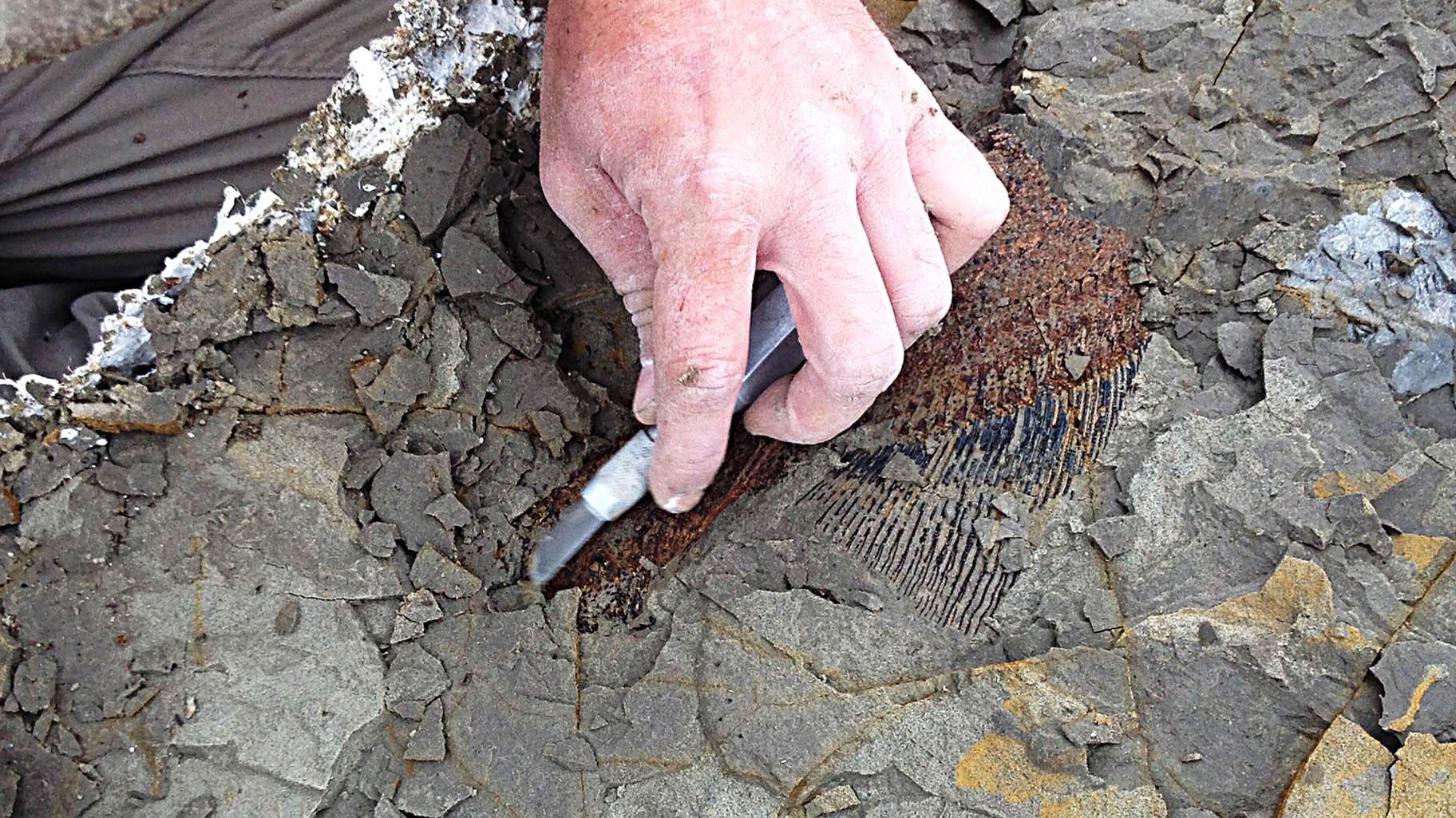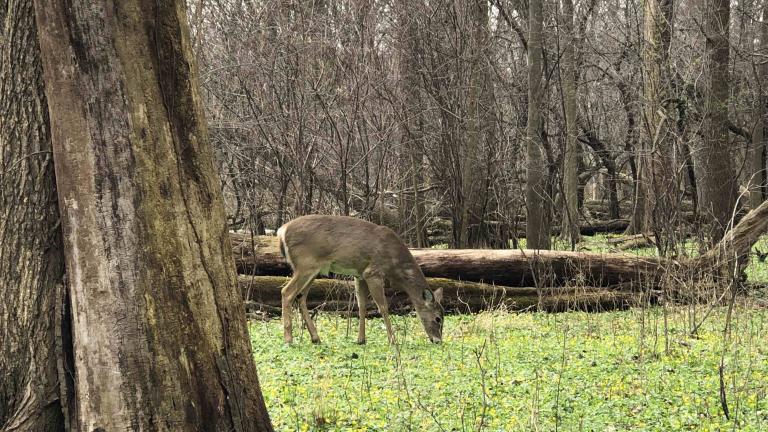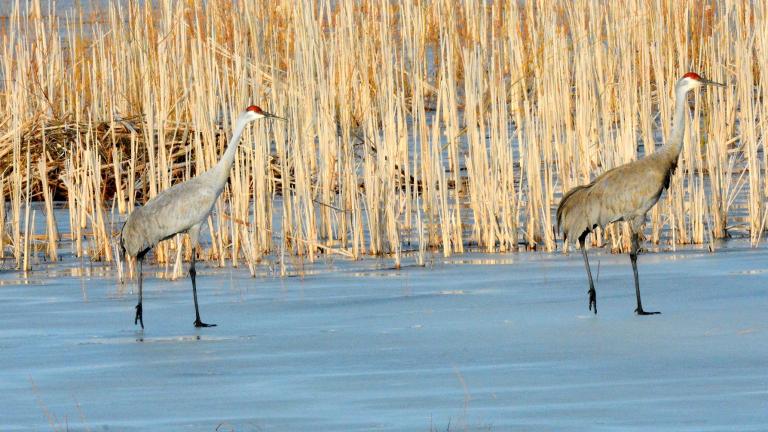It’s now widely accepted by scientists that most dinosaurs died out roughly 66 million years ago as a result of a massive asteroid impact that hit what is now the Yucatan Peninsula in Mexico.
That impact changed the history of life on Earth and paved the way for the rise of mammals, and ultimately, humans.
Now an international team of researchers say they have found fossilized remains of fish and a dinosaur in North Dakota at a site they have called “Tanis.” They believe the creatures died on the very day of the asteroid impact.
That story is told in a new documentary called “Dinosaur Apocalypse” airing on WTTW.
Robert DePalma, who is leading the excavation of the Tanis site, spoke with WTTW News. DePalma is an adjunct professor in the Department of Geosciences at Florida Atlantic University and a postgraduate researcher at the University of Manchester, England.
Answers have been edited for length.
Tell me about the Tanis site in North Dakota, I understand you have been studying the site since 2012. What drew you to this particular site?
Robert DePalma: It all started off with a team of commercial collectors who have been out there many years. They would quarry out and sell fossils from the Hell Creek. They approached me and said, look, we’ve got this amazing site that’s got a lot of fish. That’s really very unusual because no fish are really known from Hell Creek. Up until then, maybe three were known. They’re not that common. When we looked further into the matter it was very, very easy to see that the sediments there indicated that the depositional scenario was very violent and turbulent and involved a big water surge. And that surge came inland. All the rivers back then drained eastward into the giant seaway that split the U.S. into two back then. And the surge that caused this deposit was going the opposite direction – it was going inland.
Then we noticed the marine fossils in there, which we’d expect from the seaway. So, that confirms we have a surge. Then we start seeing all these bits of ejecta, these spheres of glass that came out of the sky that were blasted out of the crater. And the site is capped by an iridium-rich layer (from the asteroid impact) and that layer and the ejecta and everything else dates to the time of the Chicxulub impact and geochemically matches the fingerprint of the impact. So basically, we’ve got a site that locks in time, the first moments after impact of one of the most significant impacts in Earth’s history, the one that brought the Cretaceous to an end.
As you know, there are skeptics of your claims who say there needs to be more research done before they would be willing to accept your interpretation of what the Tanis site represents. What is your response to those skeptics?
DePalma: You’re never going to get everybody to agree on everything ... but my team includes some of the top minds in this field — Walter Alvarez (who, along with his father, Nobel Prize-winning physicist Luis Alvarez, developed the theory that an asteroid impact killed off most of the dinosaurs) — you wouldn’t even know about this impact if it weren’t for Walter Alvarez. We’ve put together sort of a dream team of really specialized senior researchers to investigate this. We’ve got at least three different teams who are going to come join us this coming summer. It’s a beautiful collaboration of minds and talent and that’s what leads us to the conclusions we’ve got now.
What is the Tanis site like now and what would it have been like 66 million years ago prior to the asteroid impact that is believed to have wiped out most of the dinosaurs?
DePalma: At this very moment, it would probably be very soggy with some snow on it, which is why I’m not out there digging right now. But on any normal day of excavation, you’re going to see typical Hell Creek badlands. You’re going to see rocky craggy outcrops, you’re going to see prairie grass. You might see the occasional rattlesnake. Now that contrasts completely with how it was back then. Right now, I live in south Florida and that is very close to the type of climate you would have seen in the late Cretaceous. It’s actually a little cooler right now because back then there were no ice caps on the poles because it was that warm. And it would have been a tropical to subtropical paradise back then. One of the takeaway messages from the research we’re doing there is that we are seeing signatures of absolutely vibrant life back then. It was not in decline, the dinosaurs and all the other terrestrial animals and plants, everything was bustling back then. And for all intents and purposes, it would have been a prehistoric paradise up until the moment of impact.
 Robert DePalma uncovers a preserved articulated body of a 65-million-year-old fish at Tanis. (Courtesy of Robert DePalma)
Robert DePalma uncovers a preserved articulated body of a 65-million-year-old fish at Tanis. (Courtesy of Robert DePalma)
You and your team have made some extraordinary finds, including an exquisitely preserved leg of a dinosaur that you believed died on the very day of the asteroid impact. What’s the evidence for that? How are you able to tie your finds so precisely to the day of impact?
DePalma: That’s a great question. As scientists, we never ever jump to conclusions. That’s not what you do in science. So what you do is you let the clues and the data speak for themselves and they tell you the story. And in terms of the site itself, the actual site is basically constrained to the moments after impact in a number of different ways. The surge sediments are full of ejected spherules (small glass droplets) that basically were deposited as they came out of the air after impact. Those only come out maybe one hour, maybe two hours maximum, after the asteroid impact. Walter Alvarez did the calculations himself.
Then you add on to that, that the site itself is capped by an undisturbed layer of that very, very fragile, fine grained K-Pg boundary clay (Editor’s note: the K-Pg boundary, previously known as the K-T boundary, is a thin layer of clay found across the world that contains iridium and is evidence of a massive asteroid extinction that triggered the death of more than 75% of plants and animals on the planet, including most dinosaurs) that’s enriched in iridium and shocked quartz and all those things. So the site itself is locked in time and it represents the first couple of hours maximum after impact. As far as the animals and plants, we can determine most of those were direct victims of the surge. They were alive up until the moment that they were buried. In terms of the fish, most of those fish have those ejected spherules wedged in their gills. These things were gasping for oxygenated water in that muddy water of the surge. And these spherules were coming out of the sky and the fish were sucking these things into their gills.
You’ve been studying the site now for a decade. When did you first realize that you might have something really special on your hands?
DePalma: That was sort of a step-wise process. At first we thought that we were the luckiest people on earth because we had a site packed with fish when the Hell Creek formation had only a few fish. So we thought, man, this is an incredible opportunity to study the early evolution of the paddlefish and sturgeon and these Cretaceous fish about which very little is known. And we were over the moon about that.
And then when we discovered that it was a surge event that occurred at the time of the asteroid impact. That was a game changer because that realization occurred within roughly the first year of work at the site. We found the debris in the first year but then we had to bring that back and analyze it because obviously you don’t want to jump to conclusions. Once that debris was analyzed, we could tell that the date matched the K-Pg boundary when there was a sudden mass extinction of some three-quarters of the plant and animal species on Earth approximately 66 million years ago. The geochemical signature matched the impact, all the pollen signatures at the site matched the late-Cretaceous. When all those pieces came together we were absolutely floored and we realized that every single step forward that we take in this deposit is a historic step and we could potentially find something mind-blowing.
Note: This story was updated to clarify the definition of the K-Pg boundary.








